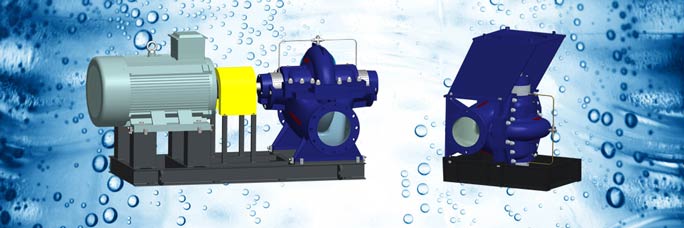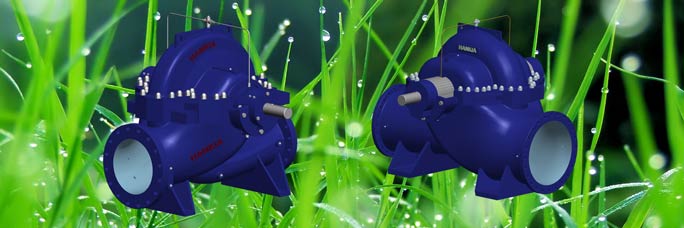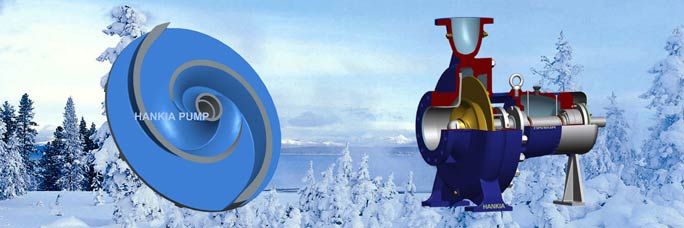Pump technology
- Pump viscosity correction
- Impeller cuts
- How to change the pump performance
- Centrifugal pump introduction
- Cavitation
- Right impeller selection
- Pump installation
- Vertical turbine pump
- Tops for specifying pumps
- Determine between end suction pump and double suction pump
- Understanding the NPSH
- Axially split case pump
Pump category
Determine between end suction pump and double suction pump
Hankia Pump supply both the end suction pump and axially split case double suction pump. So there are often multiple pump types that can be selected for the same water application, with each pump type having its own strengths and weaknesses. This column tries to help guide the end users in the selection of the best pump type that will yield the greatest reliability and lowest life cycle cost for a specific application.
End Suction Pumps for Water
For the end suction pumps in the water application, Hankia has IES type single stage end suction pump with closed impeller as standard configuration, NO type single stage end suction pump with open/semi-open impeller as the standard configuration and NE type single stage end suction pump with closed impeller and inducer impeller as the standard configuration.
Usually the single stage end suction pump would probably have the lowest initial cost for most applications, with reasonable efficiency. However, these pumps mainly follow ISO2858 (DIN24255) standards. Especially the bearing bracket and shaft seal housing is simple for single seal mechanical seal, the other types of sealing structure is optional for tailor made request. Usually these types of pumps are general used in wide fields and have large scale production to reduce the production cost. The modular design ensures the high dimensional interchangeability and reduces the stock of spare parts. They are also typically constructed with the lowest cost materials, such as cast iron casings with bronze or brass impellers. Further, there is typically more deviation from published performance, such as efficiency, for this pump type, as compared with double suction pumps.
For non-critical, intermittent service applications these pumps may be the best choice. However, for critical applications, requiring long operating life, the cost of maintenance and down time may far exceed any initial cost savings.
Kind attention: For more economic cost pump, you can refer to our ES type single stage close-coupled pump and IEC type single stage close-coupled pump.
End Suction Pumps for Chemical & Petroleum
Hankia pump designed several types of chemical and petroleum pumps to meet various application and project budget request, with ISO2858, ISO5199, ISO13709 and API610 standards. CH type general chemical pump is usually chosen by the projects with economic budget. HZ type standard chemical process pumps are the chemical process pumps that in compliance with ISO2858 and DIN24256 standard. CA (API OH1) type, CO (API OH1/OH2) type and CC (API OH2) type are have duty service petroleum and chemical end suction pumps that are in compliance with API610 and ISO13709 standards.
These chemical and petroleum pumps, which can handle corrosive, and/or toxic liquids and slurries, are available in a variety of configurations and materials, for example, stainless steel, duplex stainless steel, special alloys and other material as per application. Pumps used in this industry are different from those used in other industries, please see as below:
- Variety of material construction. The minimum casing material is ductile iron, with stainless steel being quite common, sometimes, duplex stainless steel and super alloys are used if it is necessary.
- The bearing bracket is designed for multi-cooling, forced fan cooling, cooling jacket and natural finned shape for environmental cooling.
- The bearings are usually for heavy load and ring oiled with long life span that is located on the rigid shaft.
- The cooling chamber is standard design surrounding the stuffing box. The stuffing box is usually in compliance with API 682 standards.
- Multi shaft sealing options, single mechanical seal, double mechanical seal, cartridge type mechanical seal and soft packing.
- Double volute casing design is usually the preferred hydraulic design for the casing.
- The impeller has optimized performance with high efficiency at the wide performance span and lower NPSHr.
For the petroleum and chemical end suction pumps, reliability, high efficiency, long life time, flexible interchangeability, high pressure, high temperature, low maintenance cost and suitable to corrosive liquid are the design and production target as compared with end suction pumps used in water application.
Double Suction Pump, Between Bearings, Split Case Pumps
Hankia Pump’s axially split case pumps (here we only motioned our single stage split case pump, other types of split case pump, please see our MDS multistage axially split case pump) between bearings are the second most popular centrifugal pump configuration, second only to the more common end suction pump, radial split design.
Hankia has three types of single stage axially split case pump, one is DS(V) type axially split case pump and DSR type axially split case pump that are mainly for water application. DSP type axially split case pump is designed according to API610 and ISO13709 standard that is mainly used for petroleum and chemical application.
The principal reasons for the popularity of this split case pump, between-bearing configuration include as compared with end suction pumps:
- The rotor can be removed by just taking off the upper casing half, without disturbing the suction or discharge piping, or moving the motor.
- Less shaft deflection due to the between-bearing design.
- Lower NPSH requirement due to the fact that each impeller eye only handles one half of the total pump flow rate.
- Virtually no axial hydraulic thrust, due to the back-to-back / double suction impeller design.
- Higher efficiency because power is not lost to balance the hydraulic thrust.
- Relatively high allowable nozzle loads due to the rigidity of the lower portion of the casing.
Although the split case pumps between-bearing are quite popular and have many advantages as listed above, the pumps are not without some drawbacks.
- The split case pumps usually more expansive than the end suction pump with same performance data. Due to the large flanges required for the split case sealing joint, these pumps are normally heavier and cost more than comparable end suction pumps, especially in higher alloy and higher pressure applications.
- While double suction pumps have lower NPSHr values then comparable end suction pumps, the through-shaft reduces the impeller eye area. This requires an increase in the suction eye diameter (higher eye tip speed and suction energy). Also, in order to keep the shaft bearing span to a minimum for critical speed purposes, the compressed inlet passages result in tight turns for the liquid entering the impeller eye. The gating Suction Energy and required NPSH margins tend to increase as a consequence. This phenomenon has caused field problems with high and very high suction energy pumps, when operating at low NPSH margins and/or when operating in suction recirculation. It should be noted that some of the newer split case pumps do have improved casing inlet designs (less inlet turbulence), which allows them to approach the higher suction energy performance (gating values) of end suction pumps.
- Double suction pumps are more sensitive to the orientation and geometry (radius) of elbows in front of the pump inlet. Suction elbows should be perpendicular to the plan view of the shaft. This reduces the tendency of unequal flow quantities reaching the two impeller eyes. Suction elbows in the plan of the shaft can cause uneven flow patterns which can upset the axial thrust balance, causing high bearing loads and shorter bearing life. Uneven flows to each impeller eye also tends to increase the NPSHR, and/or potentially put one half of the impeller into suction recirculation.
- Between-bearing pumps need two shaft seals, whereas only one seal assembly is required for an end suction pump. This could increase both initial and maintenance costs in services that require expensive mechanical seals.
- The axial split complicates the radial gasket sealing and can result in the mismatch of the casing halves at the joint.
- This construction also limits the mechanical seal chamber options, since most split case pumps have the stuffing boxes integral with the casing halves.
Conclusions
After the above information, we are sure of that you may have a rough idea about strengths and weaknesses of each kind of pumps and how to make a decision for a pump in our end suction pump and split case pump categories. You can determine is by considering the budget cost, bidding requirements, liquid properties, end users’ preference, ect., in order to select the best pump to completely meet the application and to minimize the maintenance and life cycle costs as well, especially for critical applications. If you are still not confirmed for your decision, do not worry, please contact Hankia Pump, our experts are waiting for your inquiry.





